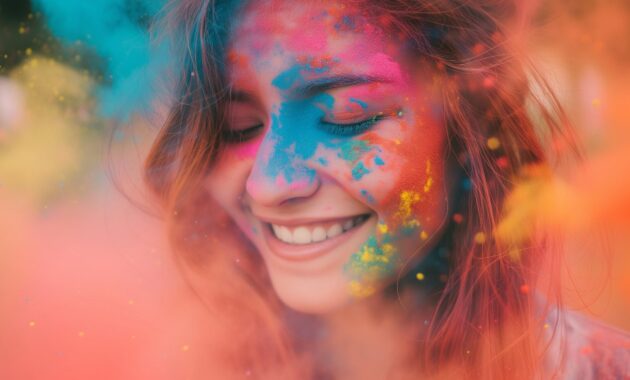The dry Holi colour is usually made of metals and toxic chemicals that can affect your skin. Here are 5 side effects of Holi colours on your skin and tips to protect it.
Delicious recipes and colours—Holi is a festival that people celebrate in all its vigour. Most people love and play Holi because this is a festival of colours. Once the festival ends, many complain of skin issues like dryness, itching, and redness. Unfortunately, some people even end up with allergic reactions due to the harmful substances present in Holi colours, including lead, chromium, cadmium, copper, mercury, nickel, and even asbestos. These compounds pose significant risks to skin health, leading to various adverse effects. Read on to understand the side effects of Holi colours on your skin.
7 side effects of Holi colours on skin
1. Sun exposure
During Holi celebrations, people often spend a long time outdoors, exposing their skin to the sun’s harmful ultraviolet (UV) rays. The combination of sun exposure and chemicals from the Holi colours can increase the risk of sunburn and long-term damage to the skin.
“To protect your skin, it’s essential to apply sunscreen at least 20 minutes before stepping out in the sun. Opt for a sunscreen with SPF 20 or higher, especially if you have pigmented patches or dry skin. In addition, don’t forget to apply the moisturiser to keep your skin hydrated,” advises Cosmetologist Ritu Khariyan.
Health Shots recommends: Best sunscreens for sensitive skin: 5 top picks to protect your skin
2. Allergic reactions
One of the most common side effects of Holi colours is allergic reactions. Many synthetic colours contain harsh chemicals like lead, mercury, and chromium, which can trigger allergic responses in people. You may notice redness, itching, swelling, and even blisters on the skin if you are developing an allergy. If you already know that your skin is sensitive, avoid using Holi colours.
Also Read


3. Dryness
Holi colours often contain drying agents like talc or silica, which can strip natural oils and moisture off the skin, leaving your skin dry, rough, and dehydrated. In fact, it can also make your skin more prone to cracking, flaking, and peeling.
4. Skin irritation
“The chemicals present in Holi colours can cause irritation and inflammation on the skin, especially if you spend a lot of time playing Holi,” says Khariyan. Moreover, if the colour is not washed off properly, it can lead to dryness, redness, and a burning sensation.
Also read: 8 homemade face masks that can help you repair your skin post-Holi
5. Rashes and redness
Holi colours, especially those that contain toxic chemicals and irritants, can cause rashes and redness on the skin. Friction on the skin from playing with colours can increase the risk of chafing and micro-tears on the skin’s surface, which can result in red, inflamed patches that may be tender to the touch.
6. Chemical burns
Holi colours can also trigger chemical burns on the skin. These burns may range from mild to severe, depending on the type of colour you use and the duration of exposure to harmful chemicals. In some cases, the burns can be so severe that they require medical attention and may leave behind scars or pigmentation issues.
Select Topics of your interest and let us customize your feed.
PERSONALISE NOW
7. Acne breakouts
Acne breakout may not result immediately after playing Holi with colour but after some time, you may notice acne on your face. “The heavy oils and dyes in Holi colours can clog pores and lead to acne breakouts,” explains Khariyan. Along with acne, you may also notice blackheads or whiteheads, especially in people with oily or acne-prone skin.

How to protect skin from Holi colour?
To protect your skin from the potential side effects of Holi colours, follow these 10 tips:
1. Apply a thick layer of moisturiser or coconut oil to your skin before stepping out to play Holi. This creates a barrier between your skin and the colours.
2. After the moisturiser, apply sunscreen or face oil to shield against harmful UV rays.
3. Use body lotion to keep the skin hydrated and less susceptible to damage.
4. Apply vaseline to protect the sensitive skin around the eyes.
5. Wear full-sleeved clothes and cover as much skin as possible to minimise direct contact with colours.
6. Opt for breathable cotton clothing and avoid synthetic or tight clothes, as they can cause rashes and allergic reactions.
7. Don’t forget to drink plenty of water to avoid dehydration.
8. Shield your face with sunglasses and a scarf or bandana to protect it from colour splashes.
9. Use natural or organic colours made from flowers, as they are less likely to cause skin irritation.
10. Avoid using harsh chemical-based colours, as they can cause allergic reactions and skin irritation.
Tips for post holi skincare
These tips can help you keep your skin protected after playing Holi:
- Rinse your face with lukewarm water and mild soap to remove Holi colours .
- Avoid scrubbing vigorously, as it can further irritate the skin.
- Apply a layer of moisturiser after a bath to hydrate and calm your skin.
- If you feel any sort of irritation, burning sensation, or itching, you may apply aloe vera gel to calm it.
- Keep yourself hydrated after the festivities to help flush out toxins and maintain skin health.
Keep these tips in mind when you plan to play Holi this year! Happy Holi!
#side #effects #Holi #colours #skin
